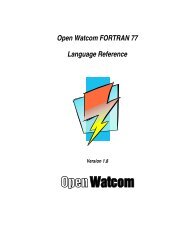Relocatable Object Module Format (OMF) Specification
Relocatable Object Module Format (OMF) Specification
Relocatable Object Module Format (OMF) Specification
Create successful ePaper yourself
Turn your PDF publications into a flip-book with our unique Google optimized e-Paper software.
<strong>Relocatable</strong> <strong>Object</strong> <strong>Module</strong> <strong>Format</strong><br />
Appendix 3: Obsolete Records and Obsolete Features of Existing Records<br />
This appendix contains a complete list of records that have been defined in the past but are not part of the TIS<br />
<strong>OMF</strong>. These record types are followed by a descriptive paragraph from the original Intel 8086 specification. When<br />
linkers encounter these records, they are free to process them, ignore them, or generate an error.<br />
Obsolete Records<br />
6EH RHEADR R-<strong>Module</strong> Header Record<br />
This record serves to identify a module that has been processed (output) by<br />
Microsoft LINK-86/LOCATE-86. It also specifies the module attributes and gives<br />
information on memory usage and need.<br />
70H REGINT Register Initialization Record<br />
This record provides information about the 8086 register/register-pairs: CS and<br />
IP, SS and SP, DS and ES. The purpose of this information is for a loader to set<br />
the necessary registers for initiation of execution.<br />
72H REDATA <strong>Relocatable</strong> Enumerated Data Record<br />
This record provides contiguous data from which a portion of an 8086 memory<br />
image may eventually be constructed. The data may be loaded directly by an<br />
8086 loader, with perhaps some base fixups. The record may also be called a<br />
Load-Time Locatable (LTL) Enumerated Data Record.<br />
74H RIDATA <strong>Relocatable</strong> Iterated Data Record<br />
This record provides contiguous data from which a portion of an 8086 memory<br />
image may eventually be constructed. The data may be loaded directly by an<br />
8086 loader, but data bytes within the record may require expansion. The<br />
record may also be called a Load-Time Locatable (LTL) Iterated Data Record.<br />
76H OVLDEF Overlay Definition Record<br />
This record provides the overlay's name, its location in the object file, and its<br />
attributes. A loader may use this record to locate the data records of the overlay<br />
in the object file.<br />
78H ENDREC End Record<br />
This record is used to denote the end of a set of records, such as a block or an<br />
overlay.<br />
7AH BLKDEF Block Definition Record<br />
This record provides information about blocks that were defined in the source<br />
program input to the translator that produced the module. A BLKDEF record will<br />
be generated for every procedure and for every block that contains variables.<br />
This information is used to aid debugging programs.<br />
7CH BLKEND Block End Record<br />
This record, together with the BLKDEF record, provides information about the<br />
scope of variables in the source program. Each BLKDEF record must be<br />
followed by a BLKEND record. The order of the BLKDEF, debug symbol<br />
records, and BLKEND records should reflect the order of declaration in the<br />
source module.<br />
76 <strong>OMF</strong> <strong>Specification</strong>, Version 1.1 Tool Interface Standards (TIS)
















